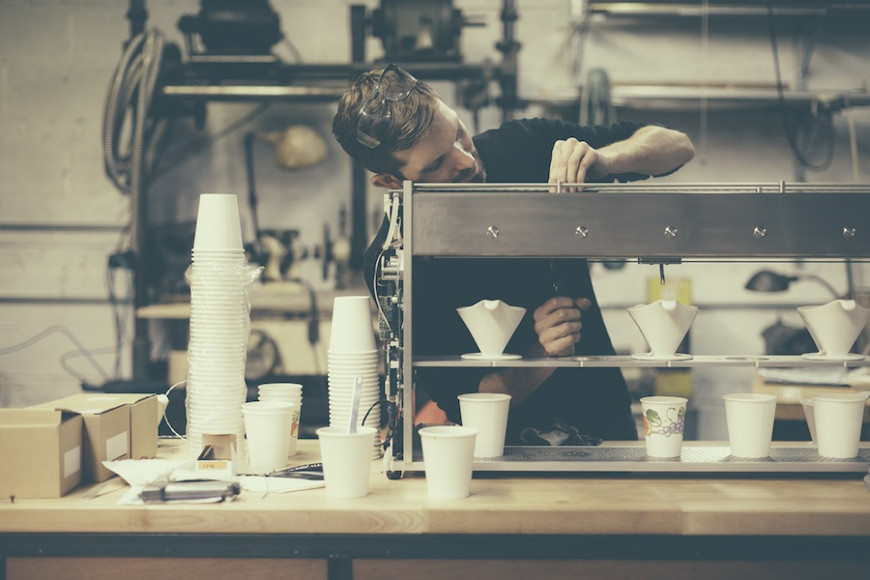Some see the handcrafted artisan movement as a rebellion against technology and automation. But innovators who are both mechanically and culinarily creative, like Brooklyn-based start-up Poursteady, see craft and tech helping each other hand in hand.
Or, in Poursteady’s case, no hands: The Gowanus start-up of space-technology engineers and coffee geeks has invented a pour-over machine that does the pouring for you — up to five cups of filter coffee at a time with finely tuned precision. Get ready to greet your pour-over robot every morning.
Craft coffee has evolved much in the past decade — in New York alone, the number of high-quality, specialty cafés has grown by at least 10 orders of magnitude — so people who work in that world are continually improving, inventing. And when it comes to über-precise by-the-cup brews — which, upon ordering, can take nearly as long to arrive as a carefully crafted cappuccino — the challenges of speed, efficiency and reproducibility are high in this famously impatient city.
A pair of coffee-infused inventors, Stuart Heys (the mechanical side) and Mark Sibenac (the electrical side) saw a problem waiting to be solved after Sibenac observed painfully slow lines for pour-over coffee in the Bay Area. The handcrafted brews have gained such popularity for their dimensions of flavor and made-to-order experience that they’ve — by needing several minutes to prepare — caused a spate of barista bottlenecks. On the spot, the pair of engineers began scheming solutions. Within a year, Poursteady was born.
Using the robotics chops honed by projects for NASA, the U.S. military and other operations, the pair, working out of their Brooklyn lab and machine shop (lucky for them, Heys has a soft spot for collecting factory equipment), launched their first pour-over-making robot at the 2013 Maker Faire.
“It’s always exciting to see people who are not necessarily from the coffee industry innovating… a way they can solve a problem,” says Irving Farm Coffee Roasters’ director of wholesale, Teresa von Fuchs. “I’m a fan of all the innovations that come to help us tell better stories about where the coffee is coming from and how much goes into every cup.”
Indeed, Poursteady’s goal is to empower the barista to rely on her skills to dial in proper coffee and water ratios for each coffee, right down to the way water is poured, all while freeing her up to better engage the customer. Working via an iPhone app that communicates directly with the machine, Poursteady works just like dialing in any other drip or espresso coffee: the barista’s expertise and palate that will determine grind size, dose and even water pattern — spiral, zigag, that symbol Prince was using for awhile. The machine can accommodate any filter cone of the barista’s choice — Hario V60, Kalita Wave, Beehouse, Bonmac, Melitta, et al. And if you want Poursteady to pour into your Chemex, a simple removal of its center tray lets you do that, too.
Hayes and Mihalko have since rolled out the Poursteady cart at other builder/maker shows and tested it at Long Island City’s Coffeed and the Joe Coffee Pro Shop in Chelsea. Capable of making 460 cups of perfect pour-over coffee in an eight-hour stretch, Poursteady made its official international industry debut at the Specialty Coffee Association of America conference in Seattle this April and is getting ready to populate café countertops in the coming months.
Unlike a lot of other inventors in the coffee-equipment world, Poursteady came in not through the coffee community but from the engineering side. Stephan von Muehlen, a cofounder of the company alongside Hayes and Mihalko, says the process has been a coffee crash course.
“We’ve been talking to the folks at Irving Farm and at Joe Coffee and Blue Bottle,” says von Muehlen. “Everyone has been really supportive and helpful, and through that we’ve learned a lot about where the Third Wave [of coffee] is coming from and going to.”
And until espresso-based drinks can make themselves five at a time, they’d better watch their backs.
Photo credit: Scott Gordon Bleicher



